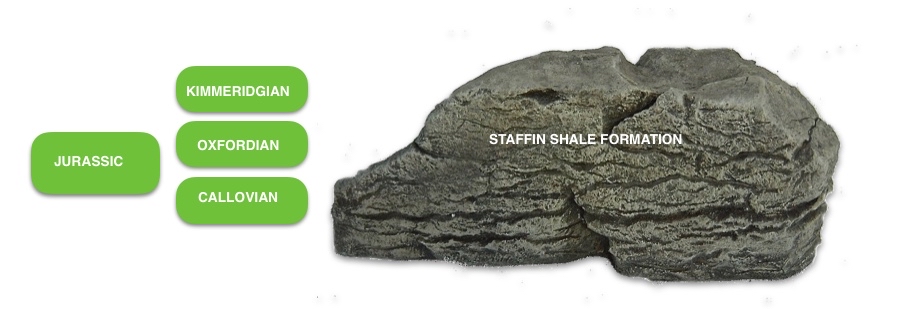Flodigarry is a very picturesque beach, with amazing views and Oxfordian sediments, containing good pyrite and calcite fossils. The wild seas can add drama to this location, and the wildlife is second to none. This is a great place to spend a day with a picnic and a look for fossils on the low tide.
DIRECTIONS
♦ Take the A855 from Portree to Staffin and Uig.
♦ Turn off at the first sign for Flodigarry on right-hand side.
♦ There is free parking, with good access close by. It is a short and easy ten minute walk down to the shore.
♦ Ref: NG 46795 71540
PROFILE INFO
FIND FREQUENCY: ♦♦♦ – Due to the soft nature of the clay beds, constant erosion can often reveal fresh fossils. Low tide is the preferred time to reach the best of these.
CHILDREN: ♦♦ – This is a good place for a family with older children. However, care still needs to be taken on the slippery clay and around loose rocks. The nearest shop is a few miles back at Staffin. Public toilets are a little closer, back at the Uig turn-off
ACCESS: ♦♦♦♦ – There is free parking with good access close by. It is a short and easy ten minute walk down to the foreshore.
TYPE: – Fossils are found on the wave-cut clay beds and in loose rocks along the foreshore. Only take fossils protruding from clay that are easily removed and do not dig into the clay. Nodules can sometimes be found.
FOSSIL HUNTING
This is an SSSI. There are no restrictions to visit this area, but you must not hammer the bedrock. Look around until you find the exposed clay bedrock, among the boulder-strewn shoreline. Fossils are very obvious on the surface of this, but remember only to remove fossils on the surface or lying loose. The boulders contain many nodules that are full of bivalves, gastropods, fossilised wood fragments and other smaller remains.
Most of the zones are well represented with fossils. Flat compressed mother-of-pearl coated and pyrite ammonites can be found throughout all stages of the succession. However, they can be very difficult to preserve, so only remove one if you feel it can be saved. Cardioceras sp. seems to be the main species of ammonite. Belemnites are very easy to find here and bivalves are also present. There are also rich microfossil assemblages.

GEOLOGY
The rocks are from the Staffin Shale Formation, formed 151 to 165 million years ago during the Callovian and Kimmeridgian stages. They were formed on Jurassic shoreline environments, with sediments deposited on beaches and barrier islands. They are about 155myrs old.
Flodigarry has a complete stratigraphic succession of the Oxfordian/Kimmeridgian boundary. Zones include the evoluta, rosenkrantzi, densicostata and bauhini subzones.


SAFETY
Slippery loose rocks and clay are the main dangers. Tides come in slowly, so should not cut anyone off, providing you are sensible.
EQUIPMENT
A penknife or something similar will be sufficient for removing belemnites and other specimens exposed in the clay. A mallet will open any of the bivalve-packed nodules. Take a mobile phone as there is reception here.
ACCESS RIGHTS
This site is an SSSI. This Special Site of Scientific Interest, means you can visit the site, but hammering the bedrock is not permitted.
 Skye has a rich fossil heritage with particularly important fossils of Jurassic age. In addition to being Sites of Special Scientific Interest (SSSI) some areas of Skye’s coastline have added protection under a Nature Conservation Order (NCO). This Order seeks to protect vertebrate fossils that include the remains of dinosaurs. This guidance outlines how fossil collectors, visitors to the island and the general public have an important role in helping to look after these important fossils.
Skye has a rich fossil heritage with particularly important fossils of Jurassic age. In addition to being Sites of Special Scientific Interest (SSSI) some areas of Skye’s coastline have added protection under a Nature Conservation Order (NCO). This Order seeks to protect vertebrate fossils that include the remains of dinosaurs. This guidance outlines how fossil collectors, visitors to the island and the general public have an important role in helping to look after these important fossils.
 Scotland’s fossil resource is at risk of abuse and damage, and so we must all safeguard and managed fossil collecting to ensure its survival for future generations. For this reason it is VITAL you read and adhere to the Scottish Fossil Code for ALL sites in Scotland.
Scotland’s fossil resource is at risk of abuse and damage, and so we must all safeguard and managed fossil collecting to ensure its survival for future generations. For this reason it is VITAL you read and adhere to the Scottish Fossil Code for ALL sites in Scotland.
It is important to follow our ‘Code of Conduct’ when collecting fossils or visiting any site. Please also read our ‘Terms and Conditions‘
LINKS
♦ Buy Fossils, Crystals, Tools
♦ Location Discussions
♦ Deposits Magazine
♦ Join Fossil Hunts
♦ UK Fossils Network
















